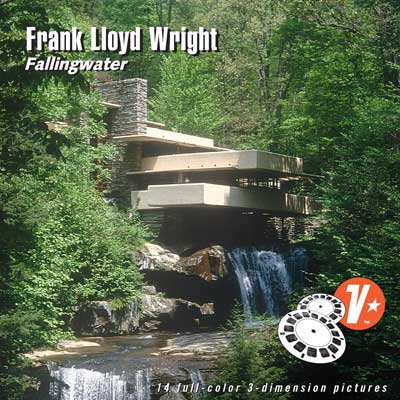Frank Lloyd Wright : Fallingwater

LINER NOTES
Wright and the 3rd Dimension
After the completion of Fallingwater in 1937, architect Frank Lloyd Wright (1867-1959) began work on a number of important residential commissions. One of these was the design of a home and studio in the hills of Malibu, California for Hollywood writer-producer Arch Oboler. Wright prepared drawings of the complex, known as Eaglefeather, and supervised the construction of its first phase in 1940-41.
Following World War II, Oboler became interested in the commercial application of stereoscopic projection technology originally developed by Dr. Edwin H. Land for military use. Encouraged by increasing popular interest in 3-D photography as well as a search by the film industry for entertainment alternatives to television, Oboler produced Bwana Devil, Hollywood's first 3-D film using the new technology.
When work resumed on Eaglefeather in 1953, Oboler sent Wright 3-D slides of the Malibu site, intended to "refresh the [architect's] memory, in three dimensions." By that time, the Stereo Realist, a camera enabling amateur photographers to take their own full-color, three-dimensional transparencies, was in regular use at Taliesin West, recording work in progress and documenting the Fellowship's social events. Captivated by the process and eager to view the wave of popular dimensional films emanating from Hollywood, Wright had 3-D projection equipment installed in the Taliesin screening room.
The Museum of Modern Art in New York had provided Wright with the first opportunity to display his work stereoscopically in 1952, when Arthur Drexler curated an exhibit of significant post-war architecture entitled Built in U.S.A. Stunning Kodachromes of the S. C. Johnson Company headquarters in Racine, Wisconsin (1939-1950) were mounted in individual Stereo Realist viewers installed around the gallery. The images perfectly captured what Drexler described as the essence of Wright's work: "the emotional experience of space, light and materials."
In an address to a group of University of Wisconsin photojournalism students in 1953, Wright cited the three-dimensional photograph as the most appropriate means of representing his work. He spoke as a lifelong creator of architecture, as well as a critic and theorist. For him, drawing was only a means to communicate an idea that had already been fully formed in his imagination. The reality of the building was not in its plans, sections or elevations, nor even in its perspective rendering, but in its space.
Conventional photography, which flattens volumes and distorts true readings of distance and size, collapses the experience of Wright's space from an emotional to an intellectual one. It also fails to represent the two technical and aesthetic innovations that characterize the architect's work after the turn of the century: the dissolution of interior partitions (resulting in the free flow of interior space) and the replacement of the supporting wall with the window wall, sheltered by a long, cantilevered roof (establishing a continuity of indoor and outdoor space). Finally, planar photography fails to capture accurately Wright's subtle yet deliberate manipulation of human vision and perception achieved, in his later work, through the tilting of wall planes and use of non-orthogonal geometry.
Frank Lloyd Wright understood the universal significance of Fallingwater, as did the Kaufmanns, who opened their country retreat to the public. First-time visitors, familiar with the house only through conventional photographs, are often surprised by its paradoxical combination of complexity, drama, intimacy and serenity. To those who are unable to visit Fallingwater or who wish to refresh their memories - in three dimensions - these photographs are offered as a trace of the experience.
Notes © 1998 Michael Kaplan.
